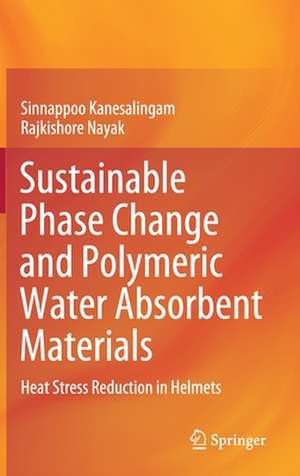Sustainable Phase Change and Polymeric Water Absorbent Materials: Heat Stress Reduction in Helmets
Autor Sinnappoo Kanesalingam, Rajkishore Nayaken Limba Engleză Hardback – 28 aug 2020
Preț: 639.73 lei
Preț vechi: 752.63 lei
-15% Nou
Puncte Express: 960
Preț estimativ în valută:
122.45€ • 133.05$ • 102.93£
122.45€ • 133.05$ • 102.93£
Carte tipărită la comandă
Livrare economică 21 aprilie-05 mai
Preluare comenzi: 021 569.72.76
Specificații
ISBN-13: 9789811557491
ISBN-10: 9811557497
Ilustrații: IX, 142 p. 73 illus., 53 illus. in color.
Dimensiuni: 155 x 235 mm
Greutate: 0.4 kg
Ediția:1st ed. 2020
Editura: Springer Nature Singapore
Colecția Springer
Locul publicării:Singapore, Singapore
ISBN-10: 9811557497
Ilustrații: IX, 142 p. 73 illus., 53 illus. in color.
Dimensiuni: 155 x 235 mm
Greutate: 0.4 kg
Ediția:1st ed. 2020
Editura: Springer Nature Singapore
Colecția Springer
Locul publicării:Singapore, Singapore
Cuprins
Development of research concept.- Existing body of knowledge.- Experimental techniques.- Results and discussion.- Conclusion.
Notă biografică
Dr. Rajkishore Nayak is currently working as a senior lecturer (Fashion Merchandising) at the Centre of Communication and Design, RMIT University, Vietnam. He completed his PhD from the School of Fashion and Textiles, RMIT University, Australia. He has around 15 years of experience in teaching and research related to Fashion and Textiles. He published about 90 peer-reviewed papers in national and international journals. Recently, Rajkishore was awarded with the "RMIT University Research Excellence Award-2015". He also received the "RMIT University Teaching and Research Excellence Award-2012" and "RMIT University International Scholarship-2008". He worked with the School of Fashion and Textiles, RMIT University, Australia from 2012-2016 in teaching and research.
Textul de pe ultima copertă
This book highlights novel applications of innovative fabrics in the design of an interlayer between the scalp and the helmet lining of motorcycle helmets to control the temperature inside the helmet. It examines various fibre microstructure configurations and fibre treatments in terms of their ability to assist in the dissipation of heat from the scalp. The findings presented here will be of considerable benefit to motorcyclists in South East Asia and other tropical regions.
Caracteristici
Covers the use of sustainable textile materials such as PCMs in reducing heat stress in motorcycle helmets Presents findings that will help helmet manufacturers to understand various concepts in managing heat stress Describes the mechanism of cooling and the mechanism of achieving thermal comfort while wearing a motorcycle helmet Helps academics and researchers to understand the problems associated with the current designs of motorcycle helmets Offers guidance on testing standards for evaluating the properties of textiles used in helmet manufacturing
